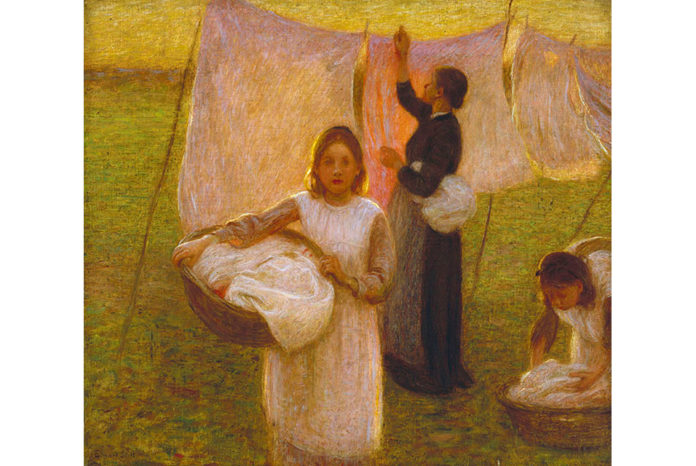Edward Stott: A Master of Colour and Atmosphere explores the work of the significant but largely neglected late Victorian artist Edward Stott (1855-1918). Much celebrated in the late nineteenth and early twentieth centuries, ‘the poet-painter of the twilight’, was known for his atmospheric and delicate depictions of rural, domestic and biblical life. Marking the centenary of Stott’s death, the exhibition brings together for the first time in over forty years, a large body of paintings spanning the artist’s life, including a number of rarely seen works.
The book Edward Stott: A Master of Colour and Atmosphere by Dr Valerie Webb, has been published by Sansom & Co. Webb is also co-curator the exhibition with Sara Cooper, Head of Collections at Towner.
Trained in Paris and initially influenced by French Impressionism and rustic naturalism, Stott did not paint in true plein air fashion, but sketched in pencil, chalk and pastels in the open air, making notes on the weather, light and colour, which he would then use to produce paintings in his studio. The exhibition includes a selection of both sketches and paintings, revealing Stott’s working process and his interest in combining the subjectivity of feeling with objective recording.
The son of a Rochdale mill owner, Stott moved to Paris in 1880 where he studied at the atelier of Carolus-Duran, and at the influential École des Beaux Arts under the artist Alexandre Cabanel. He was one of an important generation of British artists inspired by the naturalism of Jules Bastien-Lepage and Monet’s Impressionism, whose works became much sought after by the new middle classes of the late nineteenth century. During his Paris years, Stott visited the French countryside where his early works showed the influence of Corot and Bastien-Lepage. He exhibited at the Paris salons and later, in London, presented works at the Royal Academy of Art and the New English Art Club where he was one of the founding members with Philip Wilson Steer.
Stott returned to Britain and eventually settled in Amberley in West Sussex, where he drew on the local landscape, animals and people for inspiration, prompting a critic of the time to observe, ‘The scenes he pictures from that part of Sussex which he has made his own are so satisfying because of the deep knowledge and intimacy of his outlook on them’, and his painted canvases looked as if they were ‘put out into the sun to bake and to gather the dew at night’ before they were considered complete. Stott died on 19 March 1918 and is buried at Amberley.
Edward Stott: A Master of Colour and Atmosphere includes a number of works from Towner’s own permanent collection, as well as a selection of loans from national institutions including The Royal Academy, Manchester Art Gallery, Touchstones Rochdale and The National Trust.

























